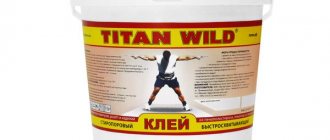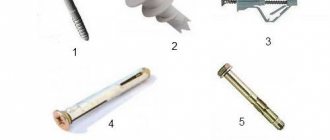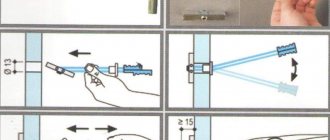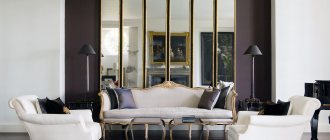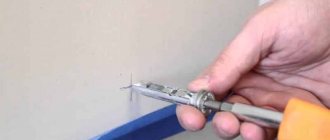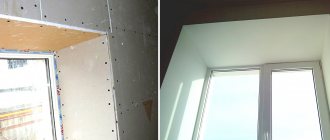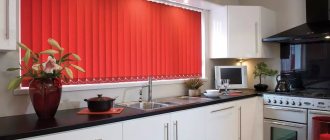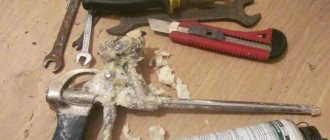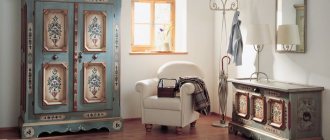Selecting a mirror
The choice of the thickness and size of the mirror is especially important when it comes to mounting it on the wall. There are some nuances that you should pay attention to before purchasing:
- Thin mirrors, as a rule, have an uneven surface, that is, they are made of poor quality. The result is a disproportionate reflection. The optimal mirror thickness is 5 mm. The thicker the mirror, the more expensive it is.
- Assess the condition of the protective coating on the reverse side.
- The mirror should be smooth. There should be no frozen air bubbles, stains, unevenness or other defects on it.
- Large mirrors (1.5-3 sq.m.) are not recommended to be hung on the wall without fastening them yourself.
- When ordering a mirror from a workshop, you must indicate its size as accurately as possible. You need to measure the interior item with a small margin of 4-5 mm. If you plan to hang a mirror in the bathroom, then you must leave a gap necessary for grouting the walls.
- The size of the mirror should correspond to the location of other interior items, that is, its edges should not touch shelves, cabinets, etc.
- To avoid having to cut the mirror surface yourself, which is quite difficult, you need to set the right task for the craftsmen.
We carefully choose a mirror for the bedroom
Mounting options
Attaching a mirror is a responsible process, since this item is fragile and can crack if handled carelessly. Before starting work, you need to decide on the height of its placement. There are no hard and fast rules in this regard. Experts advise taking into account the height of the tallest family member and adding another 3–5 cm. The lower edge should be lowered down 2–3 cm from the chin of the shortest one. But there is an important recommendation - in order to hang a mirror on the selected wall, you need to measure 1.5 m from the floor level.
Depending on the material of the surface on which you want to hang the mirror, the choice of type of fastening is determined.
Using glue and sealant
There is a reliable option to install a mirror on the wall, if its weight does not exceed 10 kg - use glue or sealant. This is a method of fastening without drilling. Domestic industry and foreign manufacturers produce a large number of special adhesive mixtures for installation. In order for the canvas to be securely fixed, the compositions must be:
- reliable;
- moisture resistant;
- have high adhesion to amalgam;
- do not contain alkalis or acids;
- have high adhesion (cohesion);
- have a high degree of polymerization;
- be white or completely transparent;
- do not have a strong odor.
If you use an adhesive that contains strong chemicals that are not intended for use on reflective surfaces, you may damage your amalgam. It is necessary to use the composition exclusively for attaching the mirror to the wall.
How to hang a mirror on the wall using glue:
- Place a frameless mirror on a previously prepared dry and grease-free wall surface using glass holders in the form of suction cups. Having decided on the height, draw marking lines.
- Install the glue capsule into the mounting gun.
- Wipe the back side of the product from dust.
- Apply the glue in strips to the inner surface of the canvas at a distance of approximately 5 cm from each other and 4 cm from the edge of the product.
- Press the canvas to the attachment point and immediately pull it towards you.
- Wait 4–5 minutes, place it on the wall, press it tightly and mount the mirror to the mounting location. To be sure, secure it with masking tape. When the glue hardens, remove the product.
Options for placing a dressing table with a mirror in the bedroom, types of product
This is a hidden fastening method. For bathrooms with high humidity, it is better to use a sealant; it contains rubber and is not afraid of dampness. The maximum thickness of the product should not exceed 6 mm.
When installed in a shower or bathroom, the adhesive composition must have antifungal properties.
Liquid nails For more reliable adhesion, glue must be applied not only to the mirror, but also to the place of placement
Using holders
Mounting for a mirror can be in the form of special devices, such as a bracket, clamp, holder, bracket. They are divided into through and non-through (ordinary). The first ones are used if there are already holes on the surface of the product; These include hangers, mounting profiles, and brackets. The latter, installed around the entire perimeter of the mirror, hold the attached canvas well. For their installation, self-tapping screws with decorative elements are used.
For small mirrors, you can use hangers. Loops made of a strong cord or thread are attached to the reverse side of the fabric. Holes are prepared by drilling and hooks are inserted into them. The mirror is held on hinges. The profile is used for large, massive products.
If the surface is uneven, it is better to secure the mirror on the wall with a non-through holder. This creates a gap ranging from 3–5 mm to several centimeters. Non-through holders are mounted on a wall or door. Work algorithm:
- Marking of attachment points (usually 2 at the bottom, 2 at the top and one on the sides). A large mirror requires additional mounting.
- Drilling holes according to marks.
- Hanging, adjusting fasteners, installing decorative strips.
This type of mirror fastening is considered one of the most reliable and practical. The product is easily dismantled and transported from place to place.
Mirror holders
For dowels and screws
In this case, the mirror is attached to the wall by drilling. Working with dowels and self-tapping screws is labor-intensive, since you need to make holes in the canvas. Of course, you can turn to specialists for help, or you can perform this procedure yourself. Attaching a mirror to the wall in this way is considered reliable, durable, and has a long service life.
Is it possible to hang a mirror opposite the front door in the hallway according to Feng Shui?
Installation of the mirror must be performed in the following sequence:
- Make marks at the fastening points.
- Using a drill, drill holes to a depth of 5–6 cm, with a diameter slightly larger than the diameter of the screw. Remove dust.
- Drive the dowel into the wall.
- Install plastic washers on the reverse side of the mirror to prevent deformation when tightening.
- Secure the mirror sheet with a self-tapping screw.
- Cover the screws with decorative covers.
Using dowels and screws, you can fix the mirror in the hallway, where it is usually installed to the full height of a person.
Using plates
It is easy to install a mirror on the wall using galvanized steel plates. They are durable and do not corrode, making them suitable for use in bathrooms. The plates are fixed to the mirror with glue. The fastening is hidden, it is not visible from the front side, it is easily dismantled. Installation features include installing the mirror from top to bottom, so to be able to move it, it is necessary to have gaps on the sides. It is recommended to stick a protective film on the amalgam to avoid injury in case of deformation.
Installation is simple:
- Make markings, taking into account the location of the glued plates.
- Secure the hooks and insert the mirror cloth into them.
- When mounting on two plates, install a silicone damper along the lower edge.
One plate can withstand a load of up to 6 kg; for large, heavy mirrors it is better to use a different mounting method.
Mirror mounting plate
With double-sided tape
This simple and affordable method is used for attaching mirrors in living rooms and bathrooms if it is light in weight. Gluing the canvas to double-sided tape will not be difficult, the main thing is that it does not slide off later. To do this you need:
- Prepare the surface - degrease and wipe off dust.
- Glue strips of adhesive tape on a foamed elastic base to the back side of the product. To achieve maximum contact, press the tape tightly to the surface with a roller or squeegee.
- Remove the protective film and attach the product. You can pick up the edge of the tape using a wire brush.
- Work should be carried out at room temperature.
The method is not recommended for fastening to silicone, polyethylene, and plastic materials. Surfaces that do not have a high load-bearing capacity are suitable, for example, plasterboard, foam blocks.
Double-sided tape is used only for vertical gluing. Its consumption is 60 cm² per 1 kg of weight. For reliable fastening, it is used for mirrors with an area of no more than 1 m².
Instructions for mounting a mirror on the wall
- First of all, you need to choose the right glue. The substances in its composition should not interact with the material from which the back side of the mirror is made. It is necessary to choose a moisture-resistant adhesive so that it can withstand the effects of condensation, especially if the mirror is mounted in the bathroom. But the most important function of the glue is to ensure the strongest possible connection between the mirror and the wall.
- The next step is choosing a base for the mirror. Often the canvas is hung on concrete, tiles or chipboard. The most suitable base is tile and concrete. The technology for mounting a mirror on these surfaces will be discussed below. It is not recommended to place a mirror on OBS or chipboard, since wood does not tolerate temperature changes well, which means it can subsequently cause the mirror to lag behind the wall.
- Next, they begin to prepare the working surface. The walls must be carefully inspected for unevenness, cracks and defects. If protrusions or chips are found, the walls are leveled. The walls need to be cleaned, leveled with cement/concrete mortar and primed. It is better to use a primer with a deep impregnation agent. The process of priming the walls is very important, since it is what protects the surface from moisture, condensation, and therefore from the growth of bacteria and mold.
Important! Even a small unevenness of a few millimeters can cause serious distortion. A poorly leveled surface can cause the canvas with the mirror to peel off from the wall.
We fix the mirror without fastenings using liquid nails or glue
Three installation methods
At first glance, all decorative wall mirrors seem the same. Of course, if the differences are in form, but this is already the work of a master, but in essence it is all the same material.
This is not actually the case, and mirrors differ from each other in several ways. We deliberately started our article with this, because before you buy and hang a mirror on the wall, you need to know about its characteristics. For different rooms it is necessary to use different mirrors, and their first and main difference is the thickness of the sheet.
The thinnest mirror can be only 4 millimeters thick. This is a very fragile product that needs to be handled with extreme care. Any awkward movement and your mirror will crack or even break completely.
The weight also depends on the thickness, and naturally, installing a heavy mirror on a wall is a much more complicated process and not every wall will withstand it.
Mirrors and amalgam may also differ. This is a special coating on the back side that turns ordinary glass into a mirror.
Cheaper models are made using aluminum amalgam. No, we cannot say that these mirrors are bad or of poor quality. Aluminum will last for many years, and it does not fade, but such mirrors have one significant drawback - they fog up when the temperature changes. This can often be observed in the bathroom when the mirror becomes covered with perspiration as soon as you turn on the hot water.
To prevent this from happening, a decorative wall mirror should be made with silver amalgam. Such mirrors are more expensive, but condensation does not form on them, and this is very convenient. On the other hand, a mirror on the wall in the living room does not need such qualities, and there is simply no point in taking such an expensive option.
So, we have figured out the characteristics of mirrors and we can move directly to the question of how to hang a mirror on the wall.
Work technology
A mirror is glued to a concrete wall like this:
- Turn the mirror back.
- Glue pieces of thick double-sided tape onto it.
- Remove the protective shell/film from it.
- Apply adhesive to the back side along the contour. It is advisable to do this in small pyramids.
- Next, the glue is applied to the surface in equal stripes - 15-20 cm.
- After the adhesive has already been applied, the mirror is pressed tightly against the wall.
- It is advisable to support the canvas with something from below, since the glue will set firmly only after 30-40 minutes. Double-sided tape performs the same function. Until the glue hardens, there is no need to tear off the tape; it will maintain a stable position of the canvas.
The technology of gluing a mirror to a “liquid nail” follows the same principle. The sealant is applied to the back wall of the canvas and waited for some time.
If the mirror is small, then only the contours are processed with a “liquid nail”. Some craftsmen advise using special holders for a while until the sealant hardens.
Useful tips for those who are doing this for the first time
- glue can be applied to the back of the mirror not only in stripes - “point technology” is also common, it is very reliable, but also involves more complex dismantling;
- if you need to glue a very large mirror to the wall, then you should first apply glue to the prepared surface of the wall and distribute it evenly over the entire surface with a special spatula with fine teeth;
- the need for a gap between the mirror surface and the wall is due to the theoretical possibility of subsidence of the house, as well as the objective difference between the thermal expansion of different materials in contact with each other;
- for gluing, you need to use only one type of glue - leave any experiments with mixing the composition for other operations;
- do not forget to make sure that the shelf life of the glue is normal - very often such compositions dry out ahead of time and lose all their qualities;
- if the mirror area is very large and the glue is unable to fix it, then try to build a small support immediately after leaning it against the wall;
- small mirrors can also be glued with double-sided mounting tape without any use of glue - it is made of polyurethane foam with a particularly sticky substance applied and is very convenient for solving such situations.
Mirror in the closet
Very often, mirrored canvases are hung on closet doors - in the hallway or bedroom. The gluing technology is simple and in many ways similar to the previous method. The first thing to do is to mark the boundaries of the future mirror on the door with a pencil. Next, special glue is applied to the back side; this must also be done along the contour and in the middle in the form of a lattice. Don’t forget about double-sided tape, which is glued every 20-30 cm in the form of vertical stripes. It is important to remember that some types of glue set very quickly, so you need to level the mirror as quickly as possible.
Save space in the bedroom: install a wardrobe with a mirror
Mirror on the wall with ceramic tiles
A mirror is an integral part of the bathroom interior. In many apartments, the bathrooms are finished with ceramic tiles, and this is an excellent basis for gluing mirror cloth. In order to hang a mirror in the bathroom without fastenings, you can use the same glue as for concrete coatings. The surface of the back of the canvas is lubricated with an adhesive composition. You need to step back 1-2 cm from the edge so that the glue does not extend beyond its contours. In the middle, glue can be applied in the form of a lattice. Once the adhesive is applied, the mirror can be pressed onto the ceramic tile. The gluing speed with this base is the same as in the case of concrete walls. The technology of work is identical. There is only one difference during installation - the edges of the mirror glued to the tile must be sealed with sealant. The color palette of these materials is not very diverse. You can choose a suitable shade - white or transparent.
Experienced craftsmen advise not to hang large mirrors alone. An assistant will be useful to support the canvas during installation. Also, a prerequisite for competent and safe work is to protect your hands from possible cuts. Fabric gloves are ideal for this purpose. If the condition of the walls allows, you can additionally secure the mirror using fasteners.
Fixing a mirror to the tiles in the bathroom
Nuances of work taking into account the type of surface
There are several types of wall surfaces on which mirrors can be attached:
- concrete;
- drywall;
- brickwork;
- PVC panels;
- tile.
Step-by-step creation of a frame for a mirror with your own hands, decor options
When installing a mirror on a wall, preliminary preparation is required. The choice of fixation method depends on the type of surface on which the canvas needs to be fixed.
| Surface type | Method of preparation | Mounting type | Tools, materials | Surface strength, mirror weight |
| Concrete | Coat with primer | Glue, sealant | Hammer, primer, glue, sealant, construction gun | Lasting, weight - 8–10 kg |
| Drywall | Clean from dirt and dust | Anchor bolts, butterfly dowels | Drill, screwdriver | Fragile, maximum weight - 20 kg |
| Brick | Coat with primer | Glue, sealant | Hammer, primer, glue, sealant, construction gun | Durable, medium weight |
| PVC panels | Installation of sheathing | Glue, tape | Glue, sealant, construction gun | Lightweight models, as the surface is fragile |
| Tile | Clean from dirt and dust | Dowel screw, glue, sealant | Concrete drills, electric drill | Not very heavy, medium surface strength |
The mounting method is selected based on the design, weight of the product, as well as the type of wall
A light mirror can be glued to a flat wall with liquid nails
You can hang a mirror on a plasterboard wall using a butterfly dowel
Rules for determining mirror installation height
Mirror on PVC panels and plasterboard
You can hang a mirror on PVC panels and drywall without fastening. But this only applies to light canvases weighing up to 25 kg. For this, “liquid nail” or special glue is used. When working with plastic panels, it is important to know that mirrors are attached to such walls by drilling only if there is a small distance between the base and the cladding. Otherwise, it will not be possible to make high-quality sheathing.
If the wall cladding is installed on a deep layer of glue, then the mirror sheet may deepen somewhat when installed using fasteners. To avoid such situations, a metal profile is attached to the covering material, and a sheet of plasterboard is fixed to it. GVL is secured using special butterfly dowels and “liquid nails”. The mirror, in turn, is glued to the drywall using moisture-resistant mounting tape and glue.
Upon contact with cement mortar, the mirror surface may darken. To prevent this, the base is treated with a special protective compound.
Attaching a mirror to drywall using butterflies
Spectacular examples in the interior
The mirror must be selected taking into account the existing interior and the overall design of the room. Below you can see several examples with the help of which the deficiencies in the configuration of the room were corrected or the emphasis was placed on successful features of the layout.
The mirror can be mounted on almost any surface. The main thing is to correctly calculate the amount of fasteners and make sure that the wall can withstand the load.
No. More answers required. I'll ask in the comments now.
35.77%
Partially. There are still questions. I'll write in the comments now.
16.67%
Voted: 246
